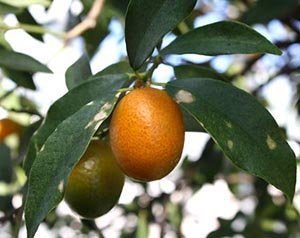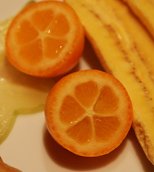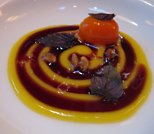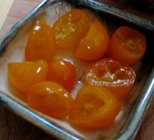Kumquat fruit Nutrition facts
Delicious, sweet yet tangy, kumquat fruit (cumquat, as the fruit generally recognized in Europe) is a winter/spring citrus special. Botanically, they belong to the Rutaceae family in the genus Fortunella and were named so after the botanist Robert Fortune who brought them from China to Europe in the middle of the 19th century.
Although kumquats taste just like that of other citrus genera fruits, they are distinguished in a way that they can be eaten wholesomely, including the peel.
 |
| Nagami kumquat fruit (Fortunella margarita).
Note for oval shaped ripe fruit with a smooth shiny surface. Photo: jskrybe |
Kumquats are a small-sized evergreen tree native to South-Eastern parts of mountainous China. Today, they are grown for their delicious fruits and as an ornamental tree in many regions of the world, including the U.S .
A mature kumquat tree bears several hundred olive-sized, brilliant orange-colored fruits in the winter. On the Interior, the fruit resembles tiny juicy orange-like segments (arils), firmly adhering to each other and with the peel. The pulp has 1-2 seeds placed centrally. The seeds are bitter in taste as in oranges, and normally, spit out.
There exist several cultivars of kumquat; however, only four of them are grown widely for their fruits.
Nagami kumquat (Fortunella margarita): The fruit is oval and is the most common variety grown in the US. It features a smooth, light yellow peel and has a tart flavor.
Marumi kumquat (Fortunella japonica): The fruit is round, and has a distinctive sweet taste and pleasant flavor.
Meiwa kumquat (Fortunella crassifolia): It is round and larger than other verities. It is popular in Japan by the name ninpo or neiha kinkan.
Hong Kong Wild (Fortunella hindsii): They are the smallest-sized kumquats.
Health benefits of Kumquat fruit
Kumquat has a calorific value equivalent to that of grapes. 100 g of fresh fruits provide only 71 calories. Nonetheless, they are one of the incredible sources of health-benefiting phytonutrients such as dietary fiber, minerals, vitamins, and pigment antioxidants that contribute immensely to overall wellness.
Kumquat is eaten along with its peel, a unique feature that differentiates it from other citrus family fruits. Its peel is rich in many essential oils, antioxidants, and fiber. 100 g whole kumquats provide 6.7 g or 17% of daily recommended levels of fiber that is composed of tannins, pectin, hemicellulose, and other non-starch polysaccharides (NSP).
Fresh kumquats are packed with numerous health benefiting polyphenolic flavonoid anti-oxidants such as carotenes, lutein, zeaxanthin, tannins, etc. Kumquat peel composes many important essential oils, including
limonene, pinene, α-bergamotene, caryophyllene, α-humulene, and α-murolene. Together, these compounds impart a unique citrus aroma to the fruit. Further, fresh fruits contain adequate levels of some of the antioxidant vitamins such as vitamins A, C, and E. Altogether, these phytochemical compounds in kumquat fruit help scavenge harmful oxygen-derived free radicals from the human body and thereby protect us from cancers, diabetes, degenerative diseases, and infections.
As in oranges, kumquats also very rich in vitamin-C. 100 g fruit provides 47.9 or 73% of RDA (Recommended daily allowances).
Vitamin-C is one of the powerful natural antioxidants that has many essential biological roles to play such as collagen synthesis and wound healing. This vitamin has antiviral and anticancer activities and helps prevent neurodegenerative diseases, arthritis, diabetes, etc by removing oxidant free radicals from the body. Furthermore, vitamin C facilitates iron absorption in the food.
Kumquat has good levels of the B-complex group of vitamins such as thiamin, niacin, pyridoxine, folates, and pantothenic acid. These vitamins function as co-factors for the metabolism of carbohydrates, protein, and fats.
Further, kumquats are a modest source of minerals like calcium, copper, potassium, manganese, iron, selenium, and zinc. Calcium is the chief element required for bone and teeth formation. Copper is needed in the production of red blood cells. Iron is required for red blood cell formation as well as for cellular oxidation.
| Principle | Nutrient Value | Percent of RDA |
|---|---|---|
| Energy | 71 Kcal | 3.5% |
| Carbohydrates | 15.90 g | 12% |
| Protein | 1.88 g | 3% |
| Total Fat | 0.86 g | 4% |
| Cholesterol | 0 mg | 0% |
| Dietary Fiber | 6.5 g | 17% |
| Vitamins | ||
| Folates | 17 µg | 4% |
| Niacin | 0.429 mg | 2.5% |
| Pantothenic acid | 0.208 mg | 4% |
| Pyridoxine | 0.036 mg | 3% |
| Riboflavin | 0.090 mg | 7% |
| Thiamin | 0.037 mg | 3% |
| Vitamin A | 290 IU | 10% |
| Vitamin C | 43.9 mg | 73% |
| Vitamin E | 0.15 mg | 1% |
| Vitamin K | 0 µg | 0% |
| Electrolytes | ||
| Sodium | 10 mg | 0.5% |
| Potassium | 186 mg | 4% |
| Minerals | ||
| Calcium | 62 mg | 6% |
| Copper | 0.095 mg | 10% |
| Iron | 0.86 mg | 11% |
| Magnesium | 20 mg | 5% |
| Manganese | 0.135 mg | 6% |
| Selenium | 0.0 mcg | 0% |
| Zinc | 0.17 mg | 1% |
| Phyto-nutrients | ||
| Carotene-ß | 0 µg | -- |
| Carotene-α | 155 µg | -- |
| Cryptoxanthin-ß | 193 µg | -- |
| Lutein-zeaxanthin | 129 µg | -- |
Selection and storage
Kumquats can be found in the markets from November through June. 'Nagami' and the ‘Meiwa’ are the two most common varieties of kumquats grown in the United States. Saint Joseph, Florida is nicknamed the kumquat capital of Florida since Nagami variety kumquats are grown on a much larger scale there.
While buying, select kumquat fruit that is firm, smooth, brilliant orange color, with the attached stem. Avoid unripe, green colored fruits and those with surface cuts, bruises, or damage.
Store them at room temperature for about 3-4 days, and inside the refrigerator for up to three weeks. Frozen kumquat puree can be stored for six months or more.
Preparation and serving tips
 |
| Kumquat cut sections with banana fruit. Photo courtesy: jlastras |

|
| Kumquat fruit as a garnish! Photo: erinmchardy |
 |
| Candied kumquats! Photo courtesy: mariko |
Kumquats must be allowed to fully ripen on the tree itself before they are picked. They can be enjoyed fresh, added in salads, or candied, and as a garnish.
Wash fresh fruits in a bowl of cool water. Gently pat dry using a soft cloth/tissue.
Kumquats are tasted best if they gently rolled or squeezed before being eaten. This method unifies sugary ingredients in its thin rind with that of underlying tart flesh. Eat kumquats as one would eat table grapes or olives, along with the peel.
Here are some serving tips:
Add fresh kumquat slices to fruit salads or fruit bowls.
Kumquats can be an attractive garnish on a platter.
Kumquats make great marmalade, preserves, and candies. It is so because, unlike other citrus fruits like Seville-orange, which has a bitter-tasting peel, kumquat rind is very sweet and, therefore desirable.
Additionally, pureed kumquats are much sought-after in the preparation of sauce, fruit concentrates, jams, and jellies.
They also can be used for the preparation of juice, cakes, pies, ice creams…etc.
Ripe kumquat fruit is also used as a marinade and as a garnish in poultry, lamb, and seafood dishes.
Safety profile
As in any other Rutaceae (citrus) category fruits, kumquat fruit can be consumed safely by pregnant, nursing mothers and children. (Medical disclaimer).
≻≻-Back to Fruits from Kumquat Fruit. Visit here for an impressive list of all varieties of fruits with complete illustrations of their nutrition facts and health benefits.
≻≻-Back to Home page.
Further reading and Resources:
Stanford School of Medicine Cancer information Page- Nutrition to Reduce Cancer Risk.
www.agroforestry.org- Citrus and Fortunella-pdf.